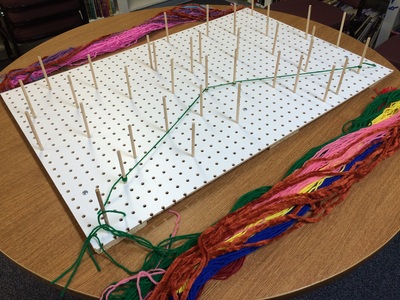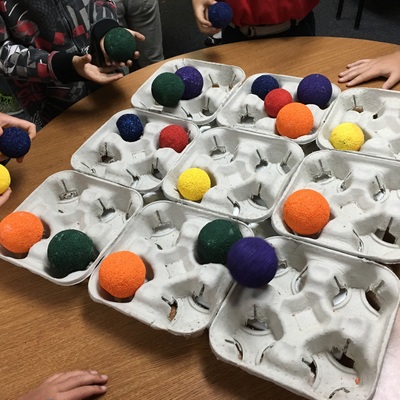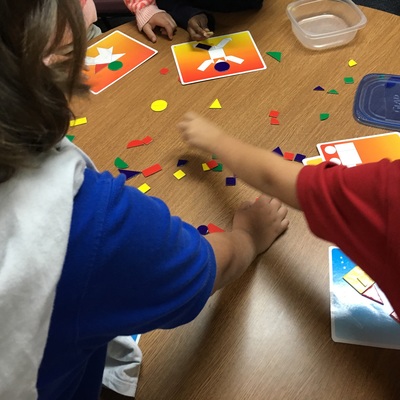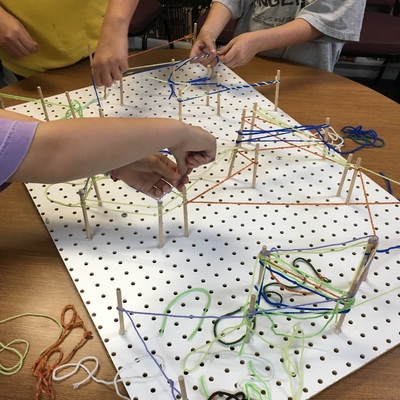The Inspiration Area developed by D'Amico provided an approach to teaching art where the child was stimulated to think creatively. They were oriented to the fundamentals of design without words or dogma of any kind (D'Amico, 1960). At D'Amico's Art Carnival one-third of the children’s time was devoted to this space. The walls were painted in blues and greens and the room was dimly light. Toys had lights focused on them from above or were lit from within. Music played in the background.
D'Amico's Art Carnival was designed for the children. Adults were allowed in viewing rooms, provided so parents could observe their children as they played and created. While children were in the Inspiration Area, the art educator was to connect with them only if instruction was needed. Verbal instruction was to be kept at a minimum.
The toys were created to convey the fundamentals of design. They stimulated creative thinking by involving "the child in aesthetic concepts of color, texture, and rhythm" (D'Amico, 1960, p. 35). While there were many elaborate toys such as the Space Ship Projector and the Color Players, there were also toys that were simple designs that could be easily replicated. D'Amico's String Picture Maker was made with a peg board and golf tees. Children wrapped colored rubber bands around the golf tees to create designs. A second toy designed by D'Amico was called the Magnetic Board. Children used colored abstract and representational shapes on the white board to visualize many arrangements of color and pattern. A third toy, the Three-Dimensional Design was a toy where students could hang different colored balls to create different patterns (D’Amico, 1960).
D'Amico's Art Carnival was designed for the children. Adults were allowed in viewing rooms, provided so parents could observe their children as they played and created. While children were in the Inspiration Area, the art educator was to connect with them only if instruction was needed. Verbal instruction was to be kept at a minimum.
The toys were created to convey the fundamentals of design. They stimulated creative thinking by involving "the child in aesthetic concepts of color, texture, and rhythm" (D'Amico, 1960, p. 35). While there were many elaborate toys such as the Space Ship Projector and the Color Players, there were also toys that were simple designs that could be easily replicated. D'Amico's String Picture Maker was made with a peg board and golf tees. Children wrapped colored rubber bands around the golf tees to create designs. A second toy designed by D'Amico was called the Magnetic Board. Children used colored abstract and representational shapes on the white board to visualize many arrangements of color and pattern. A third toy, the Three-Dimensional Design was a toy where students could hang different colored balls to create different patterns (D’Amico, 1960).
My Inspiration Area was developed from information found in D'Amico's book, Experiments in Creative Art Teaching, a MoMA press release by Bernstein, D'Amico, & Shaw (1969, p. 2), and from The Art Barge website. Special care was taken to replicate aspects of D'Amico's Art Carnival toys and one-third of the time was devoted to this space. Colors for the toys were bright and engaging. As in D'Amico's Art Carnival, music played in the background.
The first toy resembled D'Amico's String Picture Maker. I used a pegboard and wooden dowels. Students used textured yarn of different colors to string around the dowels. The second toy represented D'Amico's Magnetic Board. I used abstract and representational shapes made out of foam and cardboard. Students arranged them on a table and on cards to create colored patterns and designs. The third toy was fashioned after a Three-Dimensional Design used at the Children's Art Carnival section of the Art Barge. I made a 3D toy from fast food drink holders and painted Styrofoam balls. It also allowed students to create patterns with balls. I connected with students if instruction was needed.
The first toy resembled D'Amico's String Picture Maker. I used a pegboard and wooden dowels. Students used textured yarn of different colors to string around the dowels. The second toy represented D'Amico's Magnetic Board. I used abstract and representational shapes made out of foam and cardboard. Students arranged them on a table and on cards to create colored patterns and designs. The third toy was fashioned after a Three-Dimensional Design used at the Children's Art Carnival section of the Art Barge. I made a 3D toy from fast food drink holders and painted Styrofoam balls. It also allowed students to create patterns with balls. I connected with students if instruction was needed.
References
Art Barge. (2015). Victor D’Amico Institute of art, the Art Barge 2015. In The art barge. [Web log comment] Retrieved from http://theartbarge.com/barge/
Bernstein, S., D'Amico, V. & Shaw, E. (1969, October 30). Pioneering in art education.The Museum of Modern Art. Retrieved from
https://www.moma.org/momaorg/shared/pdfs/docs/press_archives/4364/releases/MOMA_ 1969_July-December_0057_134.pdf?2010
D'Amico, V. (1960). Experiments in creative art. New York, NY: Museum of Modern Art.
Art Barge. (2015). Victor D’Amico Institute of art, the Art Barge 2015. In The art barge. [Web log comment] Retrieved from http://theartbarge.com/barge/
Bernstein, S., D'Amico, V. & Shaw, E. (1969, October 30). Pioneering in art education.The Museum of Modern Art. Retrieved from
https://www.moma.org/momaorg/shared/pdfs/docs/press_archives/4364/releases/MOMA_ 1969_July-December_0057_134.pdf?2010
D'Amico, V. (1960). Experiments in creative art. New York, NY: Museum of Modern Art.







